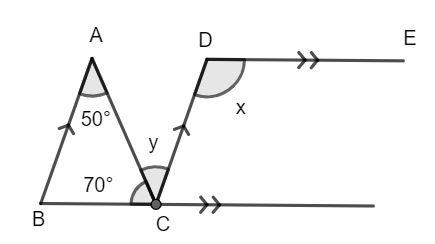
Find the values of x and y from the following figure.


Answer
530.1k+ views
Hint: Recall the properties of parallel lines and angles subtended by an intersecting line. The corresponding angles are equal and the adjacent angles add to 180°. Use this to find the values of the angles x and y.
Complete step-by-step answer:
Two lines are said to be parallel if they never meet at any finite point in space. They are always the same distance apart.
When another line intersects two parallel lines the angles formed as a result have special properties.
The alternate angles are angles formed on the opposite sides of the intersecting lines and they are equal to each other.
The corresponding angles are angles formed on the same side of the intersecting line and they are equal to each other.
The interior angles on the same side of the transversal are supplementary, that is, the sum of their angle is equal to 180°.

The lines AB and CD are parallel. The angle BAC and angle ACD are alternating angles and hence, they are equal to each other. Then, we have:
Now, we have the lines BC and DE which are also parallel. The angle BCD and the angle CDE are exterior alternate angles and hence, they are equal. Then, we have:
Now, using equation (1), we have:
Solving for x, we have:
Hence, the value of x and y are 120° and 50° respectively.
Note: You can also use interior angles properties to find the value of the angle x by finding the angle ABC using the properties of the triangle first and then evaluating.
Complete step-by-step answer:
Two lines are said to be parallel if they never meet at any finite point in space. They are always the same distance apart.
When another line intersects two parallel lines the angles formed as a result have special properties.
The alternate angles are angles formed on the opposite sides of the intersecting lines and they are equal to each other.
The corresponding angles are angles formed on the same side of the intersecting line and they are equal to each other.
The interior angles on the same side of the transversal are supplementary, that is, the sum of their angle is equal to 180°.

The lines AB and CD are parallel. The angle BAC and angle ACD are alternating angles and hence, they are equal to each other. Then, we have:
Now, we have the lines BC and DE which are also parallel. The angle BCD and the angle CDE are exterior alternate angles and hence, they are equal. Then, we have:
Now, using equation (1), we have:
Solving for x, we have:
Hence, the value of x and y are 120° and 50° respectively.
Note: You can also use interior angles properties to find the value of the angle x by finding the angle ABC using the properties of the triangle first and then evaluating.
Latest Vedantu courses for you
Grade 9 | CBSE | SCHOOL | English
Vedantu 9 CBSE Pro Course - (2025-26)
School Full course for CBSE students
₹37,300 per year
Recently Updated Pages
Master Class 11 Economics: Engaging Questions & Answers for Success

Master Class 11 Business Studies: Engaging Questions & Answers for Success

Master Class 11 Accountancy: Engaging Questions & Answers for Success

Questions & Answers - Ask your doubts

Master Class 11 Accountancy: Engaging Questions & Answers for Success

Master Class 11 Science: Engaging Questions & Answers for Success

Trending doubts
A boat goes 24 km upstream and 28 km downstream in class 10 maths CBSE

Why is there a time difference of about 5 hours between class 10 social science CBSE

The Equation xxx + 2 is Satisfied when x is Equal to Class 10 Maths

What is the full form of POSCO class 10 social science CBSE

Change the following sentences into negative and interrogative class 10 english CBSE

Discuss the main reasons for poverty in India




